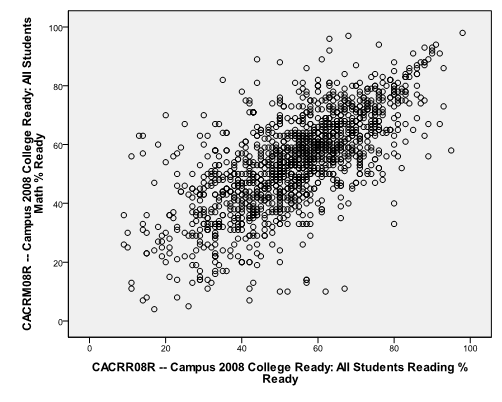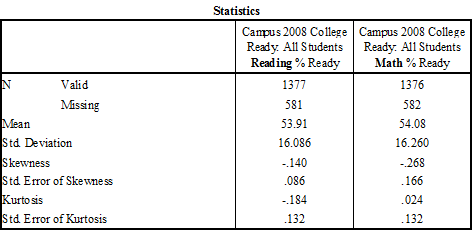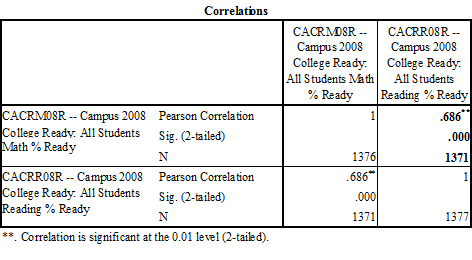| << Chapter < Page | Chapter >> Page > |

The following is an example of how to write up (in manuscript text) your Pearson Correlation statistics. This module is used with a larger Collection (Book) authored by John R. Slate and Ana Rojas-LeBouef from Sam Houston State University and available at: Calculating Basic Statistical Procedures in SPSS: A Self-Help and Practical Guide to Preparing Theses, Dissertations, and Manuscripts
College-Readiness Rates in Reading and Math: Are They Related?
The following research question was addressed in this investigation: What is the relationship between Texas high school students’ college-readiness rates in reading and in math for the 2007-2008 school year?
Prior to conducting correlational procedures, the scatterplot (present in the Appendix) was examined and was clearly suggestive of a bivariate linear relationship between the two variables. No departure from a linear relationship was evident, thereby justifying the use of a correlation coefficient. Regarding the underlying distribution of scores for college-readiness rates in reading and in math, the standardized skewness coefficients (i.e., the skewness value divided by the standard error of skewness) and the standardized kurtosis coefficients (i.e., the kurtosis value divided by the standard error of kurtosis) were calculated and yielded values that were well within the range of normality (i.e., +/- 3, Onwuegbuzie&Daniel, 2002). Readers are directed to Table 1 for the values of these standardized coefficients. Because all four coefficients were reflective of normally distributed data, a parametric correlation procedure, specifically the Pearson's product-moment correlation coefficient, was calculated.
To determine whether a statistically significant relationship was present between Texas students’ college-readiness rates in reading and math, a Pearson r was calculated. For the 2007-2008 school year, the finding was statistically significant, r (1371) = .69, p <.001, indicating the presence of a strong statistically significant positive relationship between college-readiness rates in reading and in math. Using Cohen’s (1988) values, this r value was reflective of a large relationship. Squaring this r value indicated that college-readiness rates in reading and in math overlapped 47.61%.
| Variable | Standardized Skewness Coefficient | Standardized Kurtosis Coefficient |
| Reading Readiness Rates | -1.63 | -1.61 |
| Math Readiness Rates | -1.39 | 0.18 |
| Variable | n | M | SD |
| Reading Readiness Rates | 1377 | 53.91 | 16.09 |
| Math Readiness Rates | 1376 | 54.08 | 16.26 |




Notification Switch
Would you like to follow the 'Presenting and communicating your statistical findings: model writeups' conversation and receive update notifications?